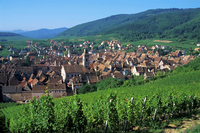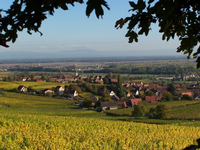For the first decade of my work as a wine writer, I probably devoted more columns in The Washington Post to Riesling from Alsace than any other grape from any other region. I believed then–as I do now–that Riesling is the world’s greatest white wine grape variety, for a whole slew of reasons. However, the general wine consuming public never really took to Riesling, and I made it my business to tell them repeatedly that they were missing out on something fabulously delicious and food-friendly.
Riesling is grown and vinified in many places around the world, but from the mid-1994 until 2005, when I was writing for the Post before leaving to help launch  Wine Review Online, Alsace was the primo place of origin for someone like me who was bent on hooking readers on Riesling. German renditions were marvelous but dauntingly complicated and often too sweet for most consumers to use without specific pairing instructions. Austrian Rieslings were just becoming available. Australia made great Rieslings, but nobody here was interested in anything but Shiraz, so importers rarely brought the wines to our shores.
Wine Review Online, Alsace was the primo place of origin for someone like me who was bent on hooking readers on Riesling. German renditions were marvelous but dauntingly complicated and often too sweet for most consumers to use without specific pairing instructions. Austrian Rieslings were just becoming available. Australia made great Rieslings, but nobody here was interested in anything but Shiraz, so importers rarely brought the wines to our shores.
Washington and Oregon were just cranking up production, as were the Canadians in British Columbia and Ontario (all of which are now making wonderful Rieslings, along with Michigan and New York’s Finger Lakes). California Rieslings could be found fairly easily, but most of them were pretty boring, as there’s just too much sun and heat in most of the Golden State to make the sleek, zesty style that most effectively lures wine lovers into Riesling World.
That left Alsace, which made reasonably priced wines that were essentially dry, widely available, fairly priced, and terrific with all sorts of foods. This last virtue made them my “go-to” whites for Thanksgiving, and I never let a year go by without using that national occasion to preach the Alsace Riesling gospel.
But then, about a decade ago, things took multiple turns, and not in good directions for Rieslings from Alsace. Dry Rieslings started appearing in  serious numbers from Germany, partly because of a change in drinking fashions in that nation, and partly due to climate change lowering acidity and lowering the need for sugar to balance it. Weirdly, many winemakers in Alsace started leaving more sugar in their Rieslings even as the Germans were moving in the opposite direction, which was a bad move both commercially and stylistically, in my opinion. Austria started sending a lot of dry or barely off-dry renditions, and this is also when Rieslings from Washington, Oregon, Canada, New York and Australia got a lot better and a lot easier to find.
serious numbers from Germany, partly because of a change in drinking fashions in that nation, and partly due to climate change lowering acidity and lowering the need for sugar to balance it. Weirdly, many winemakers in Alsace started leaving more sugar in their Rieslings even as the Germans were moving in the opposite direction, which was a bad move both commercially and stylistically, in my opinion. Austria started sending a lot of dry or barely off-dry renditions, and this is also when Rieslings from Washington, Oregon, Canada, New York and Australia got a lot better and a lot easier to find.
To be sure, exemplary producers like Trimbach never strayed from dry style Rieslings, nor did they ever miss a beat on quality. But the category of Alsace Riesling as a whole slipped badly, moving from a commanding position to just another choice among many, and a dicey choice at that, since the sweetness one would get from any particular bottle was no longer a predictable matter.
I honestly do not know how much this decline from “indispensable” to “also ran” actually hurt vintners’ bottom lines in Alsace, where tourism tends to prop everything up. But I do know that–somehow–the message got through, as Rieslings from Alsace have become notably drier and more consistently excellent in the past few years.
With Thanksgiving now around the corner, the time seems right to profile some strong cases in point. Lots of different wines work well with that famous meal, but no white wines consistently out-perform fine Alsace Rieslings. As you work down the list, the wines will get better as you go:
Domaine Loew “Muschelkalck” 2012 ($20): I have virtually no experience with this producer’s wines, despite having spent a lot of time in Alsace, but I’ll have an eye peeled from now on. This shows some lovely floral topnotes, followed by taut fruit and a finish that recalls wet stones and oyster shells. Fresh and fun, but with some complexity too. 90
Meyer-Fonné Réserve 2013 ($25): This is a fine example of a very welcome trend in Alsace toward rendering Rieslings in a dry, fresh style. The aromas show a bit of positive development with light floral notes, but the palate is flinty and mineral and almost steely. A very energetic wine with lots of linear thrust (as opposed to creamy breadth), this is a very appealing choice for freshwater fish dishes. 91
Gustave Lorentz Grand Cru Altenburg de Bergheim 2008 ($60):
This house has been on the upswing in recent years, and 2008 was an  excellent vintage that shows the boost phase of the ascent. The wine is now probably fully developed, but is at a wonderful stage at the moment, showing just a pleasant whiff of petrol on the nose, but with fruity and flowery scents as well. Rich and rounded but still structured by nice acidity, this is opulent enough to work beautifully with richer fish dishes or even slow-cooked pork. 91
excellent vintage that shows the boost phase of the ascent. The wine is now probably fully developed, but is at a wonderful stage at the moment, showing just a pleasant whiff of petrol on the nose, but with fruity and flowery scents as well. Rich and rounded but still structured by nice acidity, this is opulent enough to work beautifully with richer fish dishes or even slow-cooked pork. 91
Paul Blanck Grand Cru Schlossberg 2012 ($38): Conspicuously rich, with lots of mandarin and some light tropical notes, this is a big wine for an Alsace Riesling, and yet it is nearly as graceful as it is impressive. Mineral tinges and other nuances emerge as one re-tastes this, and I suspect the wine’s sheer size obscures this layered character at first blush. 92
Josmeyer Grand Cru Brand 2012 ($70): A very lean, fresh expression of Alsace Riesling with a very low 3 grams per liter of residual sugar, this is a bit tight for the moment, but a very classy wine for pairing with lighter seafood dishes now (or somewhat more robust foods after it loosens up and fills out in the many years of positive development that lie ahead for it). 92
Hugel Estate 2012 ($35): Sourced entirely from vineyards owned by the Hugel family, this wine bears an “Estate” inscription on the label that is very much worth watching for. It gets off to a great start with a very bight, expressive bouquet and follows up with a fresh, zesty, lemony finish that just won’t quit. Energetic and taut for now but built to unwind and improve for years to come, this is a terrific wine and an excellent value. 93
Schlumberger Grand Cru Saering 2012 ($35): This house is fortunate to possess the single most enviable swath of vineyards in all of Alsace, but the wines weren’t always terribly exciting in years past. That has changed recently, with many of the different bottlings showing much better focus, structure, and overall stylishness. This is a good case in point, with subtle aromas showing light floral notes and mid-palate flavors that suggest citrus fruits above all. Stony, mineral notes kick in on the finish, and as the wine warms a bit in the glass, it shows ever greater complexity while retaining its beautiful proportionality. This will improve for years to come and is definitely a wine to buy–as I definitely plan to do. 93
Albert Mann Grand Cru Furstentum 2013 ($45): Despite the fact that Mann winemaker Maurice Barthelmé told me that 2014 is THE vintage for Alsace’s best Riesling producers, this 2013 offering from the Grand Cru Furstentum vineyard is so striking that I can only wonder how good the 2014 may be. This is very rich and generous in initial impression, with mandarin orange notes at the forefront. Despite its opulence, the wine shows lots of inner energy, and I was extremely surprised to learn that if contains 17 grams per liter of residual sugar, as it actually tastes fruity but not sweet. A gorgeous wine. 94
Zind-Humbrecht Grand Cru Rangen Clos St. Urbain 2013 ($85): This famous house is a favorite for many lovers of Alsace wines, but I confess to being somewhat ambivalent. The wines are almost always striking in some respect, but often I find them rather overblown or too sweet to suit my palate (and my culinary preferences). With that noted, I must say that I have no reservations regarding this particular release, and indeed found it eye-poppingly delicious and stylistically exciting. The big, billowing bouquet exudes sexiness and is highly alluring, and the flavors really deliver on all that aromatic promise. Rich in body for a Riesling (from anywhere in the world), the flavors are almost dark in tone, suggesting candied fruits and even showing a smoky character that I associate more with Pinot Gris than Riesling. And yet, despite all the richness, the wine is nicely structured with acidity and almost grainy in its minerality, which is quite uncanny when considered in tandem with its prodigious palate weight. Similarly, the wine comes off as natural and graceful despite its flamboyance, which is a remarkable accomplishment. This is quite the thrill ride, and you must taste it if you can…. 94
Schoffit Grand Cru Rangen de Thann Clos Saint-Theobald 2013 ($60): This isn’t the most forceful or attention-grabbing Riesling I’ve tasted from Alsace recently, but for sheer proportionality and stylishness and overall beauty, it would be my choice. It achieves wonderful expressiveness in both aroma and flavor in a dry style, yet leaves an overall impression of coolness and restraint. This is attributable to impeccable balance and integration, as all of the components seem perfectly interwoven. Wines like this have a rare ability to retain their proportionality even as they age and gain complexity in the bottle, and I’ll be keeping an eye on this as it develop over the next decade. 95
